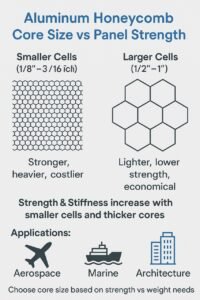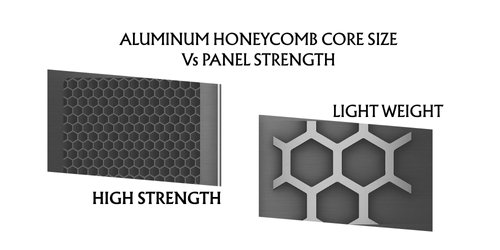Aluminium Honeycomb panels are widely used across aerospace, marine, transport, architectural, and industrial sectors. One key factor in determining the performance of these panels is the size of the honeycomb core. But how exactly does core size impact panel strength, weight, and overall functionality?
In this blog, we break down the science behind core size and its relationship with panel strength, enabling you to make informed choices for your applications.
What is Aluminum Honeycomb Core Size?
The honeycomb core is made of hexagonal cells, and its size is typically defined by the diameter of these cells, ranging from 1/8 inch (3.2mm) to 1 inch (25.4mm) or more.
- Smaller cell sizes (e.g., 1/8”, 3/16”) – More cells per area, denser structure.
- Larger cell sizes (e.g., 3/4”, 1”) – Fewer cells per area, more open space.
Impact on Panel Strength
- Smaller Cell Sizes = Higher Compressive & Shear Strength
Smaller cells distribute applied loads more evenly, resulting in:
- Higher compressive strength (resistance to crushing)
- Higher shear strength (resistance to sliding forces)
- Greater impact resistance
This makes small-cell cores ideal for aerospace floors, train interiors, and structural applications where strength-to-weight ratio is critical.
- Larger Cell Sizes = Lower Strength but Lighter Weight
Larger cells reduce the density of the core, which:
- Decreases panel weight significantly
- Reduces compressive and shear strength
These panels are suitable where weight savings outweigh strength requirements, such as non-structural partitions or decorative panels.

aluminium honey comb
Effect on Panel Stiffness
Panel stiffness depends on core thickness and cell size:
- Smaller cells + thicker core = Higher stiffness
- Larger cells + thinner core = Lower stiffness
Hence, designers choose cell size and thickness combinations based on required deflection resistance.
Manufacturing Cost Considerations
Smaller cell cores are:
- More expensive due to more material usage per area
- Heavier per unit volume
Larger cell cores are:
- More cost-effective for non-critical strength applications
Typical Applications Based on Core Size
|
Core Size |
Application |
|
1/8″ to 3/16″ |
Aerospace flooring, structural panels, transport walls |
|
1/4″ to 3/8″ |
Marine bulkheads, lightweight architectural panels |
|
1/2″ to 1″ |
Partitions, displays, furniture panels |
Optimizing Your Design
When selecting aluminum honeycomb panels, consider:
Load requirements (compressive, shear, flexural)
Weight constraints for transportation or installation
Environmental exposure (moisture, temperature, chemicals)
Cost-effectiveness based on strength needed
Consulting with your supplier or structural engineer will ensure the best balance between core size, strength, and budget.
Selecting the correct honeycomb core size is essential for achieving optimal panel performance. Smaller cells deliver superior strength and stiffness, while larger cells provide excellent weight savings for non-structural applications.
Evaluate your project requirements carefully to make the right choice and maximize safety, functionality, and cost-efficiency.
📞 Ready to choose the right honeycomb panel for your project? Contact our team today to get expert guidance and the best solution for your needs.

